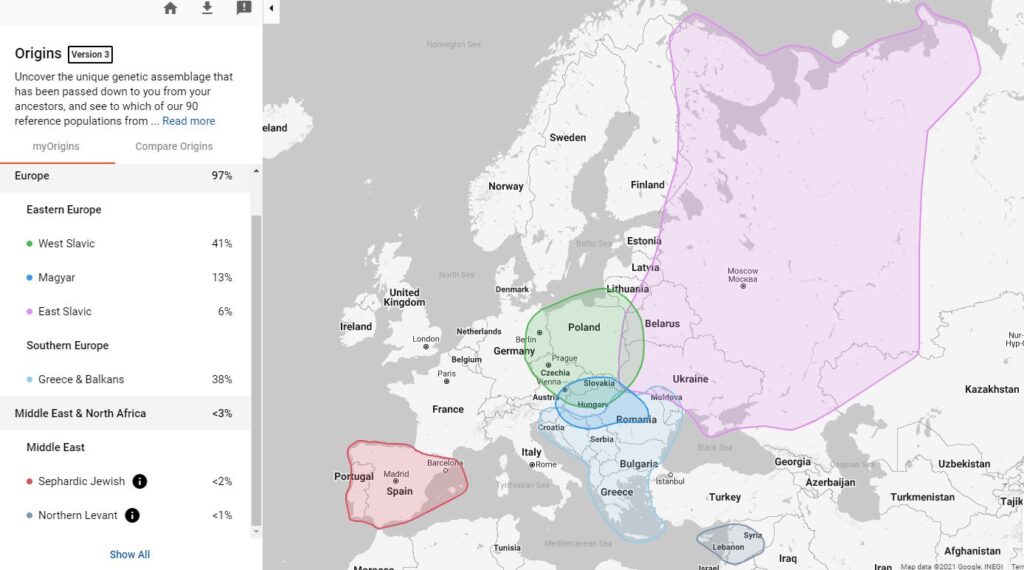In this post I want to share my FamilyTreeDNA (FTDNA) myOrigins results. If you want to learn more about the FTDNA ethnicity estimates, you should read this page (the page talks about the update to version 3 of myOrigins) and this page (myOrigins Version 3.0 population clusters).
Before I show my ethnic breakdown, I should give you some background information about myself. All my grandparents were ethnic Romanians or considered themselves to be Romanian. Both grandparents on my father’s side are from Western Moldavia or Romanian Moldavia. The grandparents from my mother’s side are from Crișana, a region between Transylvania and Hungary. I also know that a great-great-grandmother from my father’s side was a Russian speaker from Ukraine. Overall, I am half Moldavian and half “Crisanean”.
myOrigins 3.0

In the image above you can see that my estimates are: 41% West Slavic, 38% Greece and Balkans, 13% Magyar, 6% East Slavic, about 2% Sephardic Jewish and about 1% Northern Levant. The map shows the area associated with each ethnicity. The Sephardic Jewish ethnicity is associated with Spain on the map. The Sephardic and Levant percentages are considered trace percentages and they are more likely to be misattributed.
For comparison, my mother has the following estimates: 36% Greece and Balkans, 21% West Slavic, 20% Magyar, 13% England, Wales and Scotland, 7% Baltic and about 4% Sephardic Jewish(trace).
My father has : 59% West Slavic, 27% Italian Peninsula , 7% Magyar, 5% East Slavic, about 2% Ashkenazi Jewish (trace) and about 1% Inuit (trace).
Overall, I would say that the results make sense. My West Slavic and Magyar percentages are the most clear. I am slightly more East Slavic than my father, but this is probably connected to the 7% Baltic estimate for my mother (the Baltic and the East Slavic population clusters should be very similar). I don’t get any Italian Peninsula from my father, but I get a lot of Balkans and Greece, like my mother. In version 2 of myOrigins, the Italian Peninsula and the Balkans were clustered together as Southeast Europe. So the Italian Peninsula population cluster is probably pretty close to the Balkan cluster.
It is interesting that I don’t get any England, Wales and Scotland from my mother, and she has 13% (a relatively big percentage). I remember that she had more than 20% West and Central Europe in Version 2. My most western component is the 41% West Slavic cluster.
Before WW2, there were many Jews in Romania (especially in many cities from Moldavia). So the Jewish trace percentages make sense (my Northern Levant percentage is probably also Jewish related).
ancientOrigins
As part of their autosomal DNA testing, FTDNA also offers an ancient origins breakdown. My estimates are : 49% Farmer, 35% Hunger-Gatherer and 16% Metal Age Invader. For some reason, the Metal Age component makes me think of Conan the Barbarian and my mind starts hearing the Conan theme (Anvil of Crom). Other than that, I don’t know what to add about these percentages. In the end, I am more interested in the more modern populations.
Conclusions
It was curiosity that pushed me to do DNA testing. I also convinced my parents to do DNA testing, to get a better picture. In the end, there were no big surprises.
I also uploaded my results to my GEDmatch account. GEDmatch has a few additional applications that are for free. Besides ethnicity composition estimates, they also have ethnicity distance estimates. The distance estimates show your genetic distance from various ethnic groups, so you can see what ethnicities are closest to you. I will discuss my GEDmatch results in another post.
In the future I may also talk about my Y-DNA (paternal) and mtDNA (maternal) haplogroups. The tests that determine your haplogroups are more expensive than the autosomal DNA tests. I actually got into DNA testing because I wanted to determine my haplogroups.
